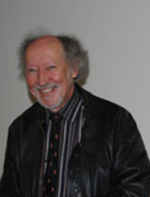A relational database is a digital database based on the relational model of data, as proposed by E. F. Codd in 1970. A software system used to maintain relational databases is a relational database management system (RDBMS). Many relational database systems have an option of using the SQL for querying and maintaining the database.
The relational model (RM) for database management is an approach to managing data using a structure and language consistent with first-order predicate logic, first described in 1969 by English computer scientist Edgar F. Codd, where all data is represented in terms of tuples, grouped into relations. A database organized in terms of the relational model is a relational database.
SQL is a domain-specific language used in programming and designed for managing data held in a relational database management system (RDBMS), or for stream processing in a relational data stream management system (RDSMS). It is particularly useful in handling structured data, i.e. data incorporating relations among entities and variables.

An object-relational database (ORD), or object-relational database management system (ORDBMS), is a database management system (DBMS) similar to a relational database, but with an object-oriented database model: objects, classes and inheritance are directly supported in database schemas and in the query language. In addition, just as with pure relational systems, it supports extension of the data model with custom data types and methods.
Fabian Pascal is a consultant to large software vendors such as IBM, Oracle Corporation, and Borland, but is better known as an author and seminar speaker. Born in Romania, Pascal lives in the San Francisco, CA area of the US, and works in association with Christopher J. Date.

Chris Date is an independent author, lecturer, researcher, and consultant, specializing in relational database theory.

Hugh Darwen is a computer scientist who was an employee of IBM United Kingdom from 1967 to 2004, and has been involved in the history of the relational model.

Edgar Frank "Ted" Codd was an English computer scientist who, while working for IBM, invented the relational model for database management, the theoretical basis for relational databases and relational database management systems. He made other valuable contributions to computer science, but the relational model, a very influential general theory of data management, remains his most mentioned, analyzed and celebrated achievement.
First normal form (1NF) is a property of a relation in a relational database. A relation is in first normal form if and only if the domain of each attribute contains only atomic (indivisible) values, and the value of each attribute contains only a single value from that domain. The first definition of the term, in a 1971 conference paper by Edgar Codd, defined a relation to be in first normal form when none of its domains have any sets as elements.
Dataphor is an open-source truly-relational database management system (RDBMS) and its accompanying user interface technologies, which together are designed to provide highly declarative software application development. The Dataphor Server has its own storage engine or it can be a virtual, or federated, DBMS, meaning that it can utilize other database engines for storage.
In relational databases, relvar is a term introduced by C. J. Date and Hugh Darwen as an abbreviation for relation variable in their 1995 paper The Third Manifesto, to avoid the confusion sometimes arising from the use of the term relation, by the inventor of the relational model, E. F. Codd, for a variable to which a relation is assigned as well as for the relation itself. The term is used in Date's well-known database textbook An Introduction to Database Systems and in various other books authored or coauthored by him.

Null is a special marker used in Structured Query Language to indicate that a data value does not exist in the database. Introduced by the creator of the relational database model, E. F. Codd, SQL Null serves to fulfil the requirement that all true relational database management systems (RDBMS) support a representation of "missing information and inapplicable information". Codd also introduced the use of the lowercase Greek omega (ω) symbol to represent Null in database theory. In SQL, NULL is a reserved word used to identify this marker.
The object-relational impedance mismatch is a set of conceptual and technical difficulties that are often encountered when a relational database management system (RDBMS) is being served by an application program written in an object-oriented programming language or style, particularly because objects or class definitions must be mapped to database tables defined by a relational schema.
D is a set of prescriptions for what Christopher J. Date and Hugh Darwen believe a relational database management system ought to be like. It is proposed in their paper The Third Manifesto, first published in 1994 and elaborated on in several books since then.
Sixth normal form (6NF) is a term in relational database theory, used in two different ways.
Rel is an open-source true relational database management system that implements a significant portion of Chris Date and Hugh Darwen's Tutorial D query language.
David McGoveran is an American computer scientist and physicist, software industry analyst, and inventor. In computer science, he is recognized as one of the pioneers of relational database theory. In the field of physics, his most notable work is in discrete and bit-string physics, in which he derived fundamental dimensionless constants from first principles.
Nikos Lorentzos is a Greek professor of Informatics. He is a specialist on the Relational Model of Database Management, having made contributions in the field of temporal databases, where he has co-authored a book with Hugh Darwen and Christopher J Date.
The enhanced entity–relationship (EER) model in computer science is a high-level or conceptual data model incorporating extensions to the original entity–relationship (ER) model, used in the design of databases.

In relational database theory, a relation, as originally defined by E. F. Codd, is a set of tuples (d1, d2, ..., dn), where each element dj is a member of Dj, a data domain. Codd's original definition notwithstanding, and contrary to the usual definition in mathematics, there is no ordering to the elements of the tuples of a relation. Instead, each element is termed an attribute value. An attribute is a name paired with a domain. An attribute value is an attribute name paired with an element of that attribute's domain, and a tuple is a set of attribute values in which no two distinct elements have the same name. Thus, in some accounts, a tuple is described as a function, mapping names to values.